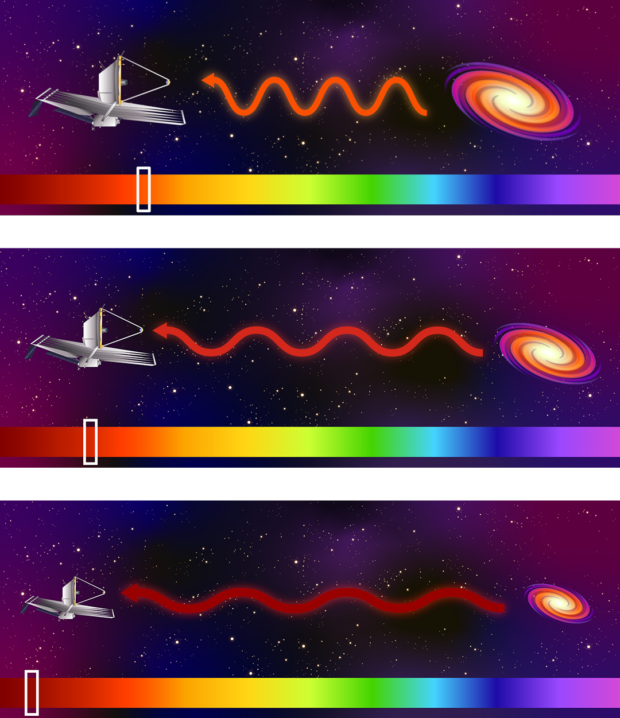Catching Ancient Stars Beyond Space and Time
Researchers at UCSC explore the early universe with the James Webb Space Telescope in search of the farthest galaxies humanity can ever find, Chiara Villanueva reports. Illustrations by Fengwei Zhang and Emma Regnier.
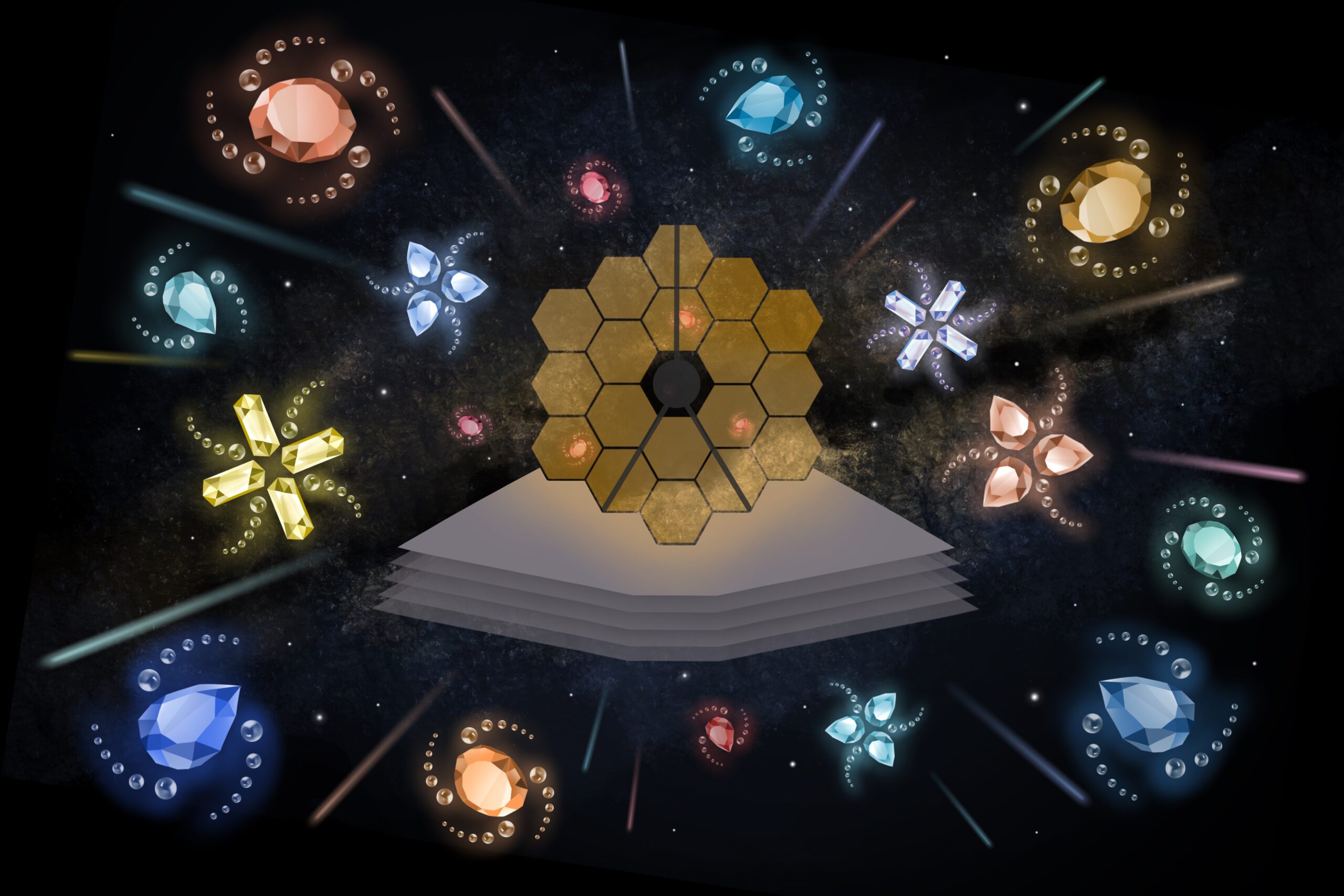
Courtney Carreira waited in anticipation as the projector beamed overhead. It was the summer of 2022, and she was interning at the Harvard & Smithsonian Center for Astrophysics in Cambridge, Massachusetts. She and her colleagues had gathered in an auditorium for a livestream watch party hosted by NASA to showcase the first images of the universe captured by the new James Webb Space Telescope.
As the first image appeared, a hush fell over the group. A myriad of galaxies from the southern constellation of Volans sparkled on the screen in pristine clarity unlike any deep space imagery Carreira had seen before. There were more than she could count: some galaxies blazed in sapphire, while others warped around a central cluster in radiant amber. Every corner teemed with vivid detail; it was like looking through a cosmic kaleidoscope.
From the stream, NASA project scientist Jane Rigby narrated excitedly: “We also see, littered like jewels in the back of the image, these faint red galaxies.” Her voice rang in the stillness of the auditorium. “That was what we built the telescope to do,” she said. “We’re seeing as they looked more than 13 billion years ago — less than a billion years after the Big Bang.”
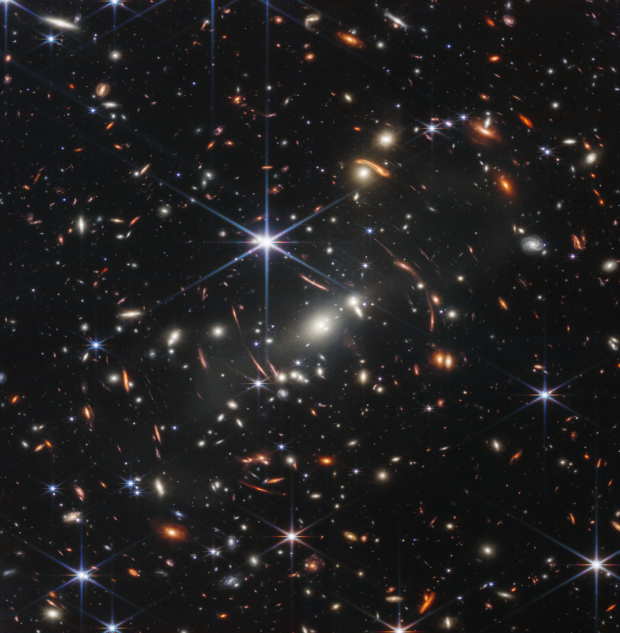
Webb’s First Deep Field, centered on the galaxy cluster SMACS 0723 in the constellation of Volans. Credit: NASA, ESA, CSA, STScI.
Carreira had mostly focused on star formation in nearby galaxies during her summer internship, primarily one of the closest to Earth called the Triangulum Galaxy. But now her curiosity stretched even deeper into the beyond. She developed a profound interest in the origin of ourselves, the Milky Way and the universe itself. Like other astronomers all over the world, her inquisitiveness drew her to further explore those “faint red galaxies” that arose just after the Big Bang. And due to the vastness of space, looking for the most remote galaxies meant peering into the past.
The James Webb Space Telescope (JWST) was built specifically to push past the limits of its predecessor, the Hubble Space Telescope — by probing even deeper back in time for these early galaxies. Now, after years of delays, JWST is in orbit around Earth and scientists are pushing the observatory to its fullest potential. Following the space telescope’s launch in December 2021, an international collaboration of astronomers called the JWST Advanced Deep Extragalactic Survey, or JADES, mobilized immediately in preparation for collecting data.
Carreira now actively researches with the consortium, which comprises fewer than a hundred scientists working to hunt for the first galaxies in the infant universe. JADES’ quest is motivated by understanding our cosmic roots, when the universe was steeped in shifting galaxies and ultradense radiation. Brant Robertson, JADES theoretical astrophysicist and a professor at UC Santa Cruz, processes baby photos of the universe taken by JWST using a special supercomputer on campus. He believes that by examining these first galaxies, JADES can get one step closer to figuring out how the universe evolved to its current form today.
In 2023, Robertson led a team of JADES scientists who successfully identified four of the most distant galaxies known to science, photographed just after the dawn of time. He worked with another JADES team led by observational astrophysicist Emma Curtis-Lake from the University of Hertfordshire to observe the characteristics of their light and determine their distances. Together, they confirmed that the light emanating from these galaxies traveled 13.4 billion light-years to reach Earth. A light-year is the distance light travels in one year, spanning about 6 trillion miles.
“There’s just so much wonderful discovery, that JWST is enabling us to see the universe in a different way.”
By revealing these four galaxies and establishing their immense distance, JADES demonstrated the power of JWST to achieve its primary goal: expanding our cosmic preview of the universe all the way back to its infancy.
“It’s just a completely new step forward in the capabilities that we have,” said Robertson, with smiling eyes. “[With JWST] it really is a revision to everything that we know about the early universe.”
Robertson and other scientists across the globe are looking forward to a new era of astronomy ushered in by JWST science. The road ahead opens up a world of unprecedented observation, with data resolved down to the finest detail. Buried in the deepest expanse of space and time, there may be a treasure trove of mysteries waiting to be discovered.
Grand Telescope, Grander Dreams
Even before Hubble had left Earth in 1990, scientists were already working on a new space telescope that would eventually surpass it. At the Space Telescope Science Institute (STScI) which operates these observatories, Deputy Director Garth Illingworth was preparing for Hubble’s launch when his boss approached him.
“Start working on the next big mission — it will take a very long time,” STScI Director Riccardo Giacconi told Illingworth. It was hard for Illingworth to say no to such a strong-willed person, and he thought that Giacconi, who would later go on to win a Nobel Prize, was right.
Illingworth assembled a small group to work on a new project they called the Next Generation Space Telescope (NGST). The idea was to send a very large space telescope into orbit, where it would “park” at a gravitationally stable point far from Earth and out of the sun’s radiation to keep its instruments cool. This telescope’s primary feature would be to peer farther back in time than Hubble.
The first official discussions of NGST occurred in 1989 at a conference between NASA and STScI in Baltimore. At the time, Illingworth had trouble imagining what would come after Hubble before Hubble’s launch. Yet in that room, he felt the enthusiasm of the crowd discussing the prospect of an even more powerful space telescope and dreaming of looking deeper into the cosmos.
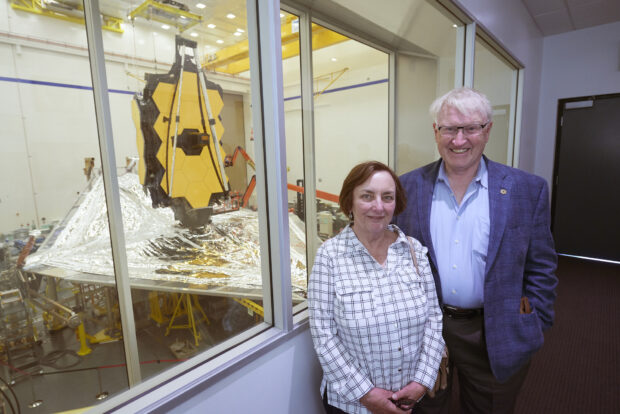
Garth and Wendy Illingworth during the JWST M8 Clean Room Viewing at the Northrop Grumman facility in Redondo Beach, California. Credit: Northrop Grumman photographer.
The NGST project officially started in March 1999. The core science goal of NGST, later renamed the James Webb Space Telescope, was to find the first galaxies at cosmic dawn. Despite decades of delays and budgeting issues, JWST persevered and launched on Christmas Day in 2021. The astronomy world held its breath as the Ariane 5 rocket soared into the sky, encasing the folded JWST like a cocoon. The launch went perfectly, and the space telescope unfolded its silver sunshield and golden mirrors above Earth according to plan. JWST floated to its destination a million miles away over the next 30 days, where it oriented itself away from the sun.
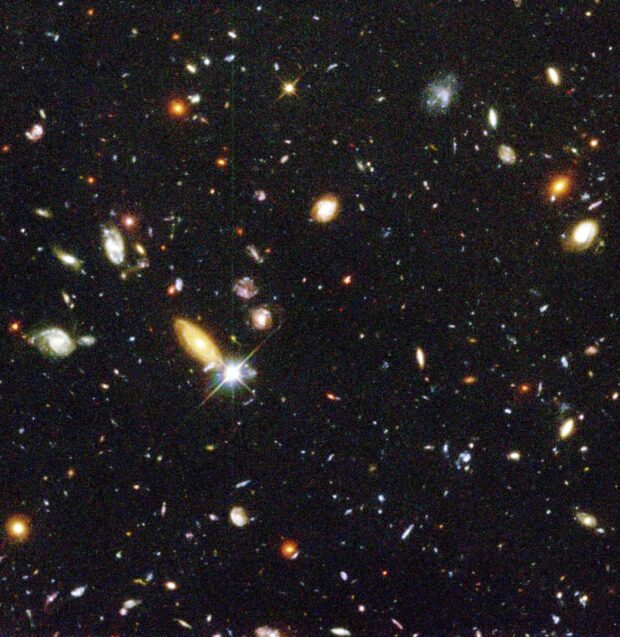
The central portion of the Hubble Deep Field, directed in the constellation of Ursa Major. Credit: NASA, Robert Williams, and the Hubble Deep Field Team (STScI).
Six months later in July 2022, Illingworth and his late wife Wendy entered the same auditorium that had held the first NGST conference 33 years earlier to watch NASA’s livestream of JWST’s inaugural images. At the same time as Carreira’s summer internship in Cambridge and millions of other awestruck viewers around the world, Illingworth saw a crystal-clear cornucopia of galaxies in immense detail. Those faint red galaxies previously invisible to Hubble gleamed in multitude across the background. It took Hubble about ten days of exposure to capture its comparably iconic Deep Field photo, while JWST captured its first interstellar masterpiece “before breakfast,” as Rigby said in the livestream.
As Illingworth toasted the telescope’s success with Wendy and his colleagues in Maryland, Carreira and her fellow interns scrambled to download JWST’s hefty high-resolution image in Massachusetts. The image was a testament to humanity that JWST’s goal of finding the first galaxies was finally within reach.
Seeing Red
For more than two decades since 1990, Illingworth and others used the Hubble Space Telescope to look for the earliest galaxies in the first billion years of the universe. Now, he continues his work with JWST as a distinguished professor at UC Santa Cruz. “JWST is our infrared Hubble on steroids,” he joked.
Hubble was constructed to be a general-purpose space telescope, but observing the universe in the infrared is the key hallmark of JWST. As the light from a distant galaxy travels towards Earth, the accelerating expansion of space stretches that light to increasingly longer wavelengths. Stretching to longer wavelengths “redshifts” it beyond the range of light visible to our eyes and into the infrared zone of the electromagnetic spectrum. The faint galaxies Rigby pointed out in JWST’s first image glinted in vermillion due to extreme redshifting. Seeing these highly redshifted galaxies requires the ability to observe infrared wavelengths at huge distances, and JWST’s infrared capabilities allow it to throw open a window into the past.
That’s why Robertson considers JWST the best tool for exploring even the faintest of galaxies. The space telescope’s 18 hexagonal mirrors, arranged like a honeycomb, provide a vast area for collecting faraway light.
Two instruments in particular form the backbone of JWST’s ability to probe the highly redshifted cosmic dawn: the Near Infrared Camera (NIRCam) and the Near Infrared Spectrograph (NIRSpec). NIRCam acts as an imager that detects light from distant galaxies, while NIRSpec disperses the incoming light into a spectrum of colors that contain vital information like distance. Combining the collective expertise of NIRCam and NIRSpec’s scientific teams created the JWST Advanced Deep Extragalactic Survey in 2015.
Robertson works in the NIRCam side of JADES in tandem with Curtis-Lake’s NIRSpec group. He also guides the scientific output of the collaboration as part of the steering committee, along with building and analyzing their massive datasets. The survey involves the efforts of many scientists worldwide, but Robertson said that Santa Cruz has a special place within JADES thanks to “lux,” the supercomputer he helped build in 2019 using a grant from the National Science Foundation.
“Almost all the image processing is done here at UCSC,” he said. “We make giant images of a part of the sky that we’ve observed, and then we run the processing to try to find galaxies and characterize their sizes and luminosities on campus.”
The Universe is the Limit
In 2013, Robertson noticed something strange while surveying an updated image from Hubble. Together with lead researcher Richard Ellis from the University College London and other scientists, their team saw a galaxy that seemed much further away than any they had ever seen before with Hubble. They were skeptical, however, as the galaxy was incredibly faint.
Ten years later in April 2023, that galaxy was one of the four confirmed by JWST as some of the most distant galaxies in the cosmos. Though their light traveled 13.4 billion light-years to reach JWST’s mirrors, the universe’s accelerated expansion means these galaxies are now 33 billion light-years away. Two of them were initially identified by Hubble and re-examined by JWST, and two were discovered by Robertson and his team. The oldest galaxy of the quartet was found at about 325 million years after the Big Bang — an exceptionally small fraction of the age of the entire universe, which is less than 2.5% of 13.7 billion years old.
After Robertson’s team captured the incoming light with NIRCam and arranged it into a set of images, Curtis-Lake and her colleagues used NIRSpec to verify each source as a galaxy and confirm their distances. The NIRCam group then measured the sizes of each of the four galaxies, and with NIRSpec’s side, they examined the stars the galaxies contained using stellar models to estimate their age and composition.
What they found is that these primordial galaxies were very small, dense and energetic. Most galaxies at present are relatively large like the Milky Way, which is currently about a hundred thousand light-years across. The early galaxies, on the other hand, were a thousand times smaller with fewer and younger stars. Their stars are estimated to be less than about 50 million years old when the age of the universe was 325 million years old.
The youth of the stars in these early galaxies told Robertson that JWST imaged them right after they had formed, supporting the idea that these galaxies had only just emerged from the galactic crucible of the Big Bang.
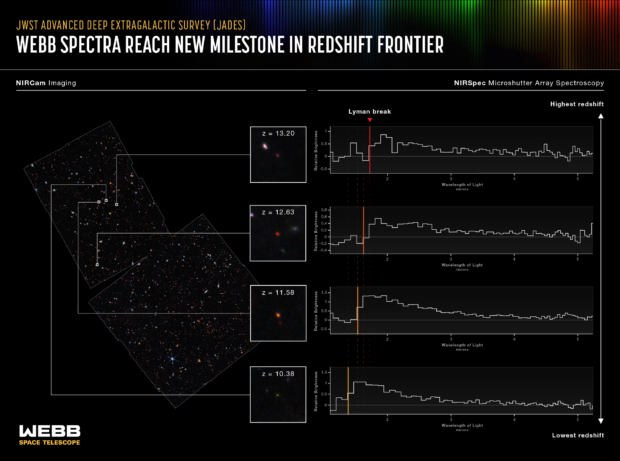
Four of the most distant galaxies detected by JWST. On the left is a mosaic of the area from which these galaxies were found, with images caught with NIRCam. On the right is each galaxy’s spectroscopy measured with NIRSpec and their corresponding redshift. Credit: NASA, ESA, CSA, STScI, M. Zamani (ESA/Webb), and L. Hustak (STScI). Science: B. Robertson (UCSC), S. Tacchella (Cambridge), E. Curtis-Lake (Hertfordshire), S. Carniani (Scuola Normale Superiore), and the JADES Collaboration.
“I was a little bit surprised at how physically small the galaxies were,” he remarked, “and it’s telling us something about the way galaxies form that we didn’t know before.”
Specifically, the findings suggested to him that galaxies can form rather quickly. Our home galaxy only creates a star like the Sun every year or so, Robertson said. But if these budding galaxies are producing stars at almost the same rate as the Milky Way in spite of their smaller size, the galaxies must be evolving efficiently due to the expedited star-forming process. Exactly how efficiently they develop in the early universe is still an open question that his team is working to better understand.
Despite having more questions, Robertson is certain of one fact: JWST has made it possible to detect and confirm the distances of highly redshifted galaxies to extreme precision. Taking photos of the deep past is only one part of the process, as scientists need to verify that the light hitting JWST’s sensors is indeed coming from emerging galaxies. This light provides signatures that both define important properties and establish their distance.
“This was a new achievement that had never been done before, going this far out in time,” said Alice Shapley, an astronomy professor at UCLA who studies how galaxies evolve over time. She stresses the importance of performing spectroscopic observations concerning distances long beyond the standard reach.
“Most of the work that’s been done so far in the early universe is based on galaxies that we think are at very high redshifts, but have not actually been spectroscopically confirmed,” Shapley noted. “[Robertson and Curtis-Lake’s teams] confirmed at redshifts higher than what was previously possible with the Hubble Space Telescope or ground-based telescopes.”
Looking Ahead with Golden Eyes
After a year of further study, Robertson and his colleagues released a new paper in 2024 that extended their reach into cosmic history. Compared to the initial hunt for galaxies as far away as possible, JADES formulated a systematic search to not only identify new early galaxies with JWST, but also quantify how many of them are forming at the earliest epochs.
Among them, his team verified the most distant galaxy in the universe at less than 300 million years after the Big Bang, beating their previous record by nearly 50 million years. The galaxy was spectroscopically confirmed by the NIRSpec group, led by Stefano Carniani from the Scuola Normale Superiore in Pisa. Although first discovered in Robertson’s original paper, the galaxy was so large and luminous that his colleagues doubted its distance until confirmation.
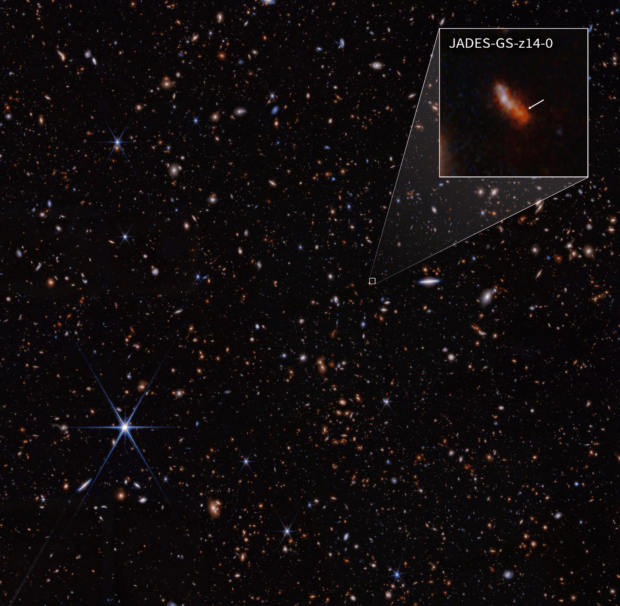
An infrared image captured by JWST’s NIRCam, with a pullout of where the most distant galaxy resides in Robertson’s new research paper. Credit: NASA, ESA, CSA, STScI, Brant Robertson (UC Santa Cruz), Ben Johnson (CfA), Sandro Tacchella (Cambridge), Phill Cargile (CfA).
“It’s so much brighter than all the other galaxies we found at a comparable time,” said Robertson. The prospect of investigating such an unusual galaxy that challenges today’s models excites him as he dives right back into the research. “It’s going to take us a little bit of time to try to wrestle with how this object could have formed, and what it tells us about the physics of galaxy formation in the early universe.”
Robertson’s next steps are to closely analyze the data for any peculiar trends that could explain the galactic record holder’s emergence, and continue assessing the spread of these objects in the early cosmos. In addition, sharing his team’s research with the public has also been an important part of his work. “One thing we really want to do with JADES is create a legacy dataset for the whole world to use,” he said.
In fact, the JADES website has an interactive map cataloging galaxies observed with JWST that he encourages everyone to see. Viewers can zoom into the map, click on individual galaxies, and view them from different parts of the electromagnetic spectrum. Robertson points out that viewers can even find the most distant galaxy from his recent study deep within the mosaic.
The first time Robertson and his colleagues looked at the completed map, they were astonished. “We couldn’t believe what we were seeing,” he said. “There’s just so much wonderful discovery, that JWST is enabling us to see the universe in a different way.”
Carreira still fondly recalls the day she first came face to face with JWST’s incredible prowess. “I remember thinking, ‘This is going to change so much about the next ten years of my life,’” she said. The curiosity sparked by that first image brought her to work with Robertson’s team at UCSC, where she helps characterize the properties of distant galaxies cataloged by JADES.
Inspecting these galactic catalogs in scrupulous detail is the first big step in Carreira’s research. Just as she was completely overtaken by JWST’s first image two years ago, she feels a similar reverence for the sheer grandiosity of the survey. The project is an ambitious endeavor, but Carreira is deeply humbled to have the privilege of working directly with JWST collaborators. Even as an early-career scientist, she is already at the forefront of astronomy, looking back 13 billion years in time to the first stellar nativities.
“We are strongly at the beginning of the James Webb era — the next revolutionary telescope — and it will bring a lot of really interesting science for young researchers,” Carreira said. “It’s an incredible time to be an astronomer, and I feel very lucky to be even a small part of it.”
© 2024 Chiara Villanueva / UC Santa Cruz Science Communication Program

Chiara Villanueva
Author
Internships: symmetry magazine, Santa Cruz Sentinel, Caltech IPAC
I loved studying astrophysics in university. But diving in to the technicalities of research, I was so focused on programming models and simulations that I couldn’t see the universe for its stars. My heart yearned for the more imaginative notions of space and time that I consumed in articles and documentaries.
Then, a science communication poster triggered a fond memory from freshman year, when I’d turned Non-Euclidean geometry into a science fiction story. “That’s right,” I thought. “I’m a writer, too.”
Having found my calling, I readily embraced every opportunity to communicate physics outside my major. The rush of weaving science and writing together spurred me to switch my trajectory from conducting research to exploring the narrative of the cosmos.
Through science communication, I aim to inform others by bringing what I find in the night sky down to Earth. After all, what inspires me about the universe is that even the wildest fantasies originate from scientific truth.
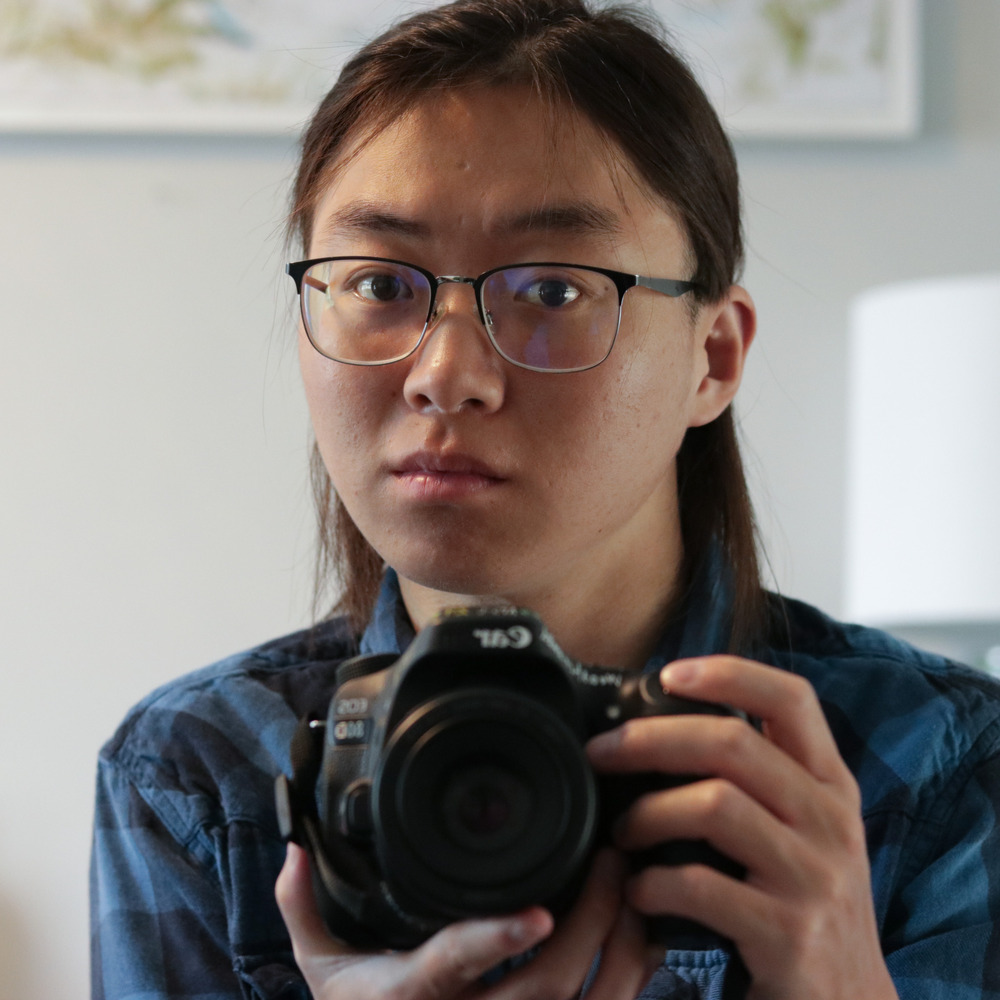
Fengwei Zhang
Illustrator
Internship: Pacific Grove Museum of Natural History
The Brainscoop is an educational YouTube channel that sparked my interest in natural history. It was hosted by Emily Graslie: a wonderfully nerdy and enthusiastic science communicator who made engaging and informative content.
I studied art when I was young and continued art studies in college. It was in college that I discovered science illustration as a career. I took scientific illustration classes at the Field Museum in Chicago and was fascinated by the collections of dead animals; whether they are skins, rocks, or in jars. After graduating, I moved to Boston and started volunteering at the Harvard Museum of Natural History. I engaged with the public and developed science communication skills while learning from passionate and knowledgeable museum educators. After volunteering for over 500 hours, I formed deep bonds with my museum colleagues and gained a wealth of experience.
I want to share my curiosity the same way Emily and museum educators did with me. I believe science is not about the absolute truth, but about the daring search for pieces of many puzzles that may never be complete.
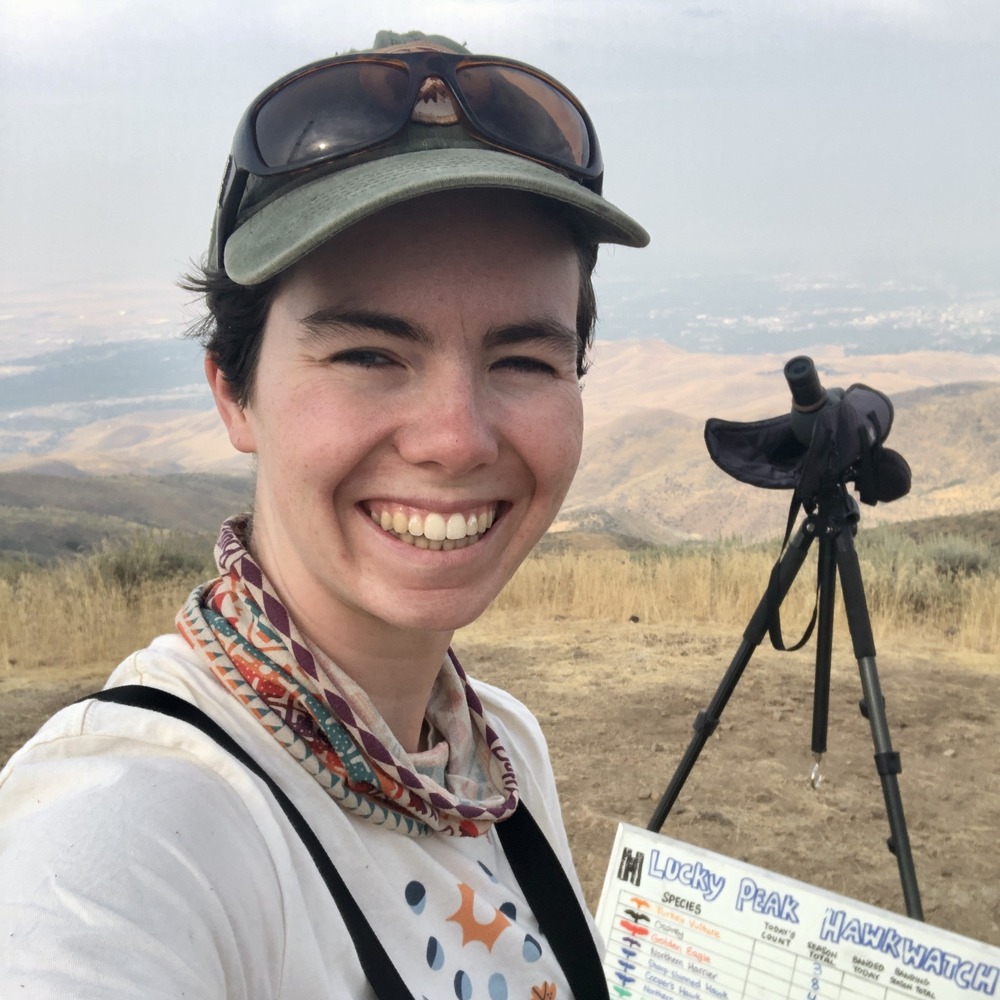
Emma Regnier
Illustrator
Internships: CSUMB Ocean Science REU Program, Mural Assistant for Jay Rasgorshek
I’m a mixed-media artist, science illustrator, ornithologist, and sketchbook enthusiast. Originally from northern Illinois, I grew up wandering the halls of the Field Museum of Natural History totally awestruck by their impressive collection of dinosaur fossils. In college, I pursued dual degrees in Fine Art and Environmental Science and spent my free time caring for captive birds of prey or looking for herptiles in the woods of upstate New York. I love to familiarize myself with new and wonderful creatures through observational drawings and my work as a wildlife biologist inspires much of my artistic practice. Art has always been central to my identity, and after years of moving around for seasonal biologist jobs, I decided to immerse myself in the formal study of scientific illustration to hone my skills as a scientific communicator. I especially enjoy sharing exciting science topics through humor and the language of comics.
